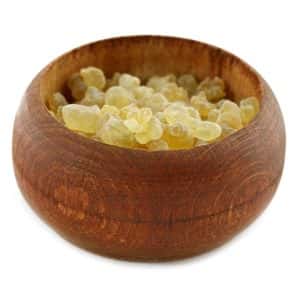
Frankincense, like myrrh, is featured in the Bible story about the three wise men visiting the infant Jesus. Like myrrh, frankincense is a resin from a tree in the family Burseraceae. (Guggul is another resin from Boswellia carteri, a tree in that family.)
Frankincense comes from Boswellia sacra, a tree that grows in Somalia and parts of Saudi Arabia. Boswellia, or Indian frankincense, comes from Boswellia serrata, a tree native to hilly regions of India.
Like guggul, this resin has a long tradition of use in Ayurvedic medicine and is almost unknown in Europe and North American herbal traditions. At least one product sold in health food stores, Boswellin, contains a standardized ethanol extract of boswellia gum.
Active Ingredients
Boswellin is standardized to 60 to 65 percent boswellic acid and its derivatives. These are the primary active ingredients in the gum resin. The volatile oil contains pinene and phellandrene, among other ingredients, and imparts a distinctive fragrance, similar to that of frankincense.
Uses
In Ayurvedic medicine, different parts of *B. serrata* were traditionally used to treat such varied health conditions as asthma, dysentery, rheumatism, ulcers, and skin disorders.
Extracts of the resin have shown unmistakable anti-inflammatory power in animals, and rats with experimental arthritis responded well to treatment without apparent side effects. Test tube research shows that boswellic acids inhibit a specific enzyme crucial in producing certain chemicals important in the process of inflammation.
A boswellic acid mixture is used in India to treat arthritis. A double-blind crossover study of patients with osteoarthritis demonstrated that a preparation containing _B. serrata_ significantly reduced disability scores and pain, although it did not alter the underlying joint deformity.
The arthritis benefits from boswellic acids may be related to their impact on glycosaminoglycan metabolism; these are the same biochemical pathways affected by glucosamine. Boswellic acid also has an effect on the immune system.
A boswellia gum resin preparation has been studied for the treatment of ulcerative colitis in comparison to sulfasalazine, a standard drug for this condition.
Over the course of six weeks, measures such as blood tests, stool analyses, and tissue pathology showed improvement. Three-fourths of the patients given sulfasalazine went into remission, and 82 percent of those on the resin preparation did so as well.
Tantalizing new research may reveal that it can help fight cancer. [BBC]
(http://news.bbc.co.uk/2/hi/middle_east/8505251.stm)
Dose
The dose utilized in the ulcerative colitis study was 350 mg three times a day. That study lasted six weeks.
Special Precautions
No special precautions are noted.
Adverse Effects
Boswellia has not been shown to cause ulcers, cardiovascular, respiratory, or psychological side effects. It might cause heartburn or gastritis, though.
In clinical trials, no side effects experienced by patients were severe enough to require them to stop participating in the study.
Possible Interactions
No interactions have been reported. Limited experience with this botanical medicine in Europe or North America may mean that it has not been widely used in conjunction with pharmaceutical medicines.

